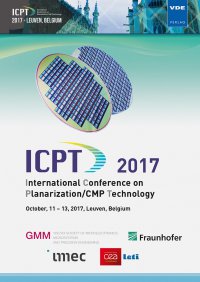Optimization of Cu Corrosion Inhibitor Concentration to Reduce Organic Defects
Conference: ICPT 2017 - International Conference on Planarization/CMP Technology
10/11/2017 - 10/13/2017 at Leuven, Belgium
Proceedings: ICPT 2017
Pages: 6Language: englishTyp: PDF
Personal VDE Members are entitled to a 10% discount on this title
Authors:
Cho, Byoung-Jun; Pyun, Hae-Jung (Department of Bio-Nano Technology Hanyang University ERICA, Ansan 15588, Korea)
Shima, Shohei; Hamada, Satomi; Hiyama, Hirokuni (EBARA Corporation, Fujisawa, Kanagawa 251-8502, Japan)
Park, Jin-Goo (Department of Bio-Nano Technology & Department of Materials Science and Chemical Engineering, Hanyang University ERICA, Ansan 15588, Korea)
Abstract:
Copper CMP process leads to various defects, for example, slurry particle, organic residue, scratch, and corrosion. Mainly copper surfaces become contaminated by slurry particles and organic residues during CMP. Silica particles and benzotriazole (BTA) are widely used as abrasives and a corrosion inhibitor, respectively in copper CMP slurries. These materials contaminate the copper surface during CMP and need to be removed at post-Cu CMP cleaning process. The concentration of inhibitor is very important because it is known to directly affect the level of organic defects. In this study, alternative inhibitor methyl-benzotriazole (MBTA) was chosen to reduce the inhibitor concentration. Even though MBTA is known as a stronger inhibitor than BTA, the optimum concentration is not reported and compared with BTA. This paper reports how to optimize and minimize the inhibitor concentration when corrosion inhibitors other than BTA have used in Cu CMP chemistry. The corrosion inhibition efficiency of MBTA was higher than BTA. Thus, it is possible to reduce the concentration of inhibitor while maintaining the same corrosion inhibition efficiency, thereby increasing the inhibitor removal efficiency which is related to the organic defectivity. Also, the relationship between particle contamination and corrosion inhibitor was discussed. Keywords: Post-Cu CMP cleaning, Corrosion inhibitor concentration, BTA, M-BTA, Electrochemical impedance spectroscopy, Organic defects


